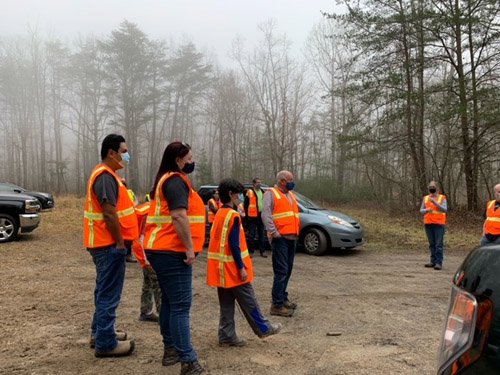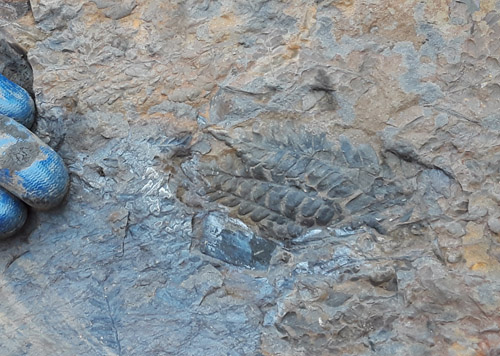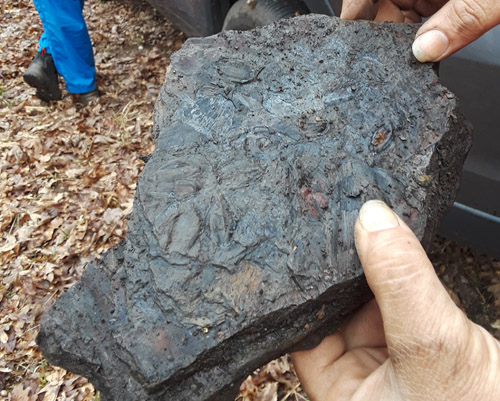GMS Field Trip March 2021
If you have any questions about field trips send email toGMS Field Trip
Pennsylvanian Age Plant Fossils in Georgia
Saturday, March 13, 2021
Jose Santamaria, Executive Director of Tellus Science Museum and member of GMS arranged a trip for 25 of us to go to collect plant fossils at the dumps of an old coal mine in Georgia. The dumps fall within the property of a trust that allows collecting for small group by permission.
On a sunny day in Atlanta, we arrived at the parking site in heavy fog, which then changed to a steady light drizzle all day (it stayed sunny in Atlanta). We gathered at the gated parking area and when all registered people were present, proceeded to the collecting site. Despite the not ideal weather conditions everybody attacked the huge mine dumps with shovels and other implements of collecting.
Jose had provided everybody with a handout with nice color pictures of Pteridosperms, Sphenopsds, and Lycopods, which could be expected to be found at this site. This made identification of our finds really easy.
After a few hours of playing in the dirt, everybody went home messy but with a nice collection of plant fossils. Jose mentioned that these fossils need to be stabilized, to prevent cracking and crumbling. He shared his recipe with us, which is published in a separate article in this newsletter.
Thanks again to Jose Santamaria for arranging an excellent outing for GMS. Hope to see you all at the next trip.
Juergen Poppelreuter, Trip Lead
On behalf of Charles Carter, GMS Field Trip Chair
e-mail:
Preparing Your Fossil Specimens
By Jose Santamaria
GENERAL GUIDELINES- Wash specimens in running water; use a very soft brush in stubborn areas. Avoid hosing off specimens as the water pressure may damage them.
- Allow the specimens to dry for at least a week in cool shade.
- Trim specimens if possible without damaging the specimens. End-cutting pliers is a tool I like to use.
COATING FOR FOSSIL SHALE
NOTE: if your specimen is already brittle and falling apart, there’s not much that can be done. If a specimen is somewhat cracked but still intact, some use Paleo-Bond, a penetrating stabilizer. I don’t like it because it leaves a glossy surface that makes the plant fossils hard to distinguish. I also strongly discourage using polyurethane or other such coatings, even if they say they are matte – the resulting gloss is very distracting.
What I use:
- A mix of Liquitex Acrylic Matte Medium and water. You can get Liquitex at an arts supply or hobby store such as Michael’s or Hobby Lobby. It’s not cheap but will last you a long time.
- Mix gently but thoroughly:
- 1/3 Liquitex acrylic matte medium
- 2/3 water
- Make sure the specimen is dry before applying the coating.
- Gently apply with a soft brush on all sides. This may take two takes since you may want to let one side dry before doing the other. Be sure to also do the sides/edges.
- This is not a penetrating solution. Instead, it seals the specimen with a thin clear acrylic film that keeps the specimens intact. And it does not leave a glossy finish
RECORDING YOUR SPECIMENS
- Regardless of what cataloguing system you use, remember that the most important information to record is the specimen name and locality (locality being most important; you can always identify it again, but if you forget the locality, that information is lost).
- If you attach a number to the back of your specimen, the matte medium at full strength makes an excellent adhesive and coating for your labels.
Photo by Robert Mangun

Safety talk before collecting
Photo by Robert Mangun

Stunning fern fossil (stablized with Paraloid B-72 as a penetrant/stabilizer )
Photo by Robert Mangun

Excellent lycopsid fossil (stablized with Paraloid B-72)
Photo by Robert Mangun

Incredibly detailed lycopsid (stablized with Paraloid B-72)
Photo by Diana Poppelreuter

Nice big specimen with leaves
Photo by Diana Poppelreuter

Awesome lepidodendron (bottom)
Photo by Diana Poppelreuter

Some very nice seed fern leaves
Photo by Diana Poppelreuter

A variety of leaf fossils
Photo by Diana Poppelreuter

Leaves and possibly some seeds
Click below for field trip policies

Copyright © Georgia Mineral Society, Inc.
